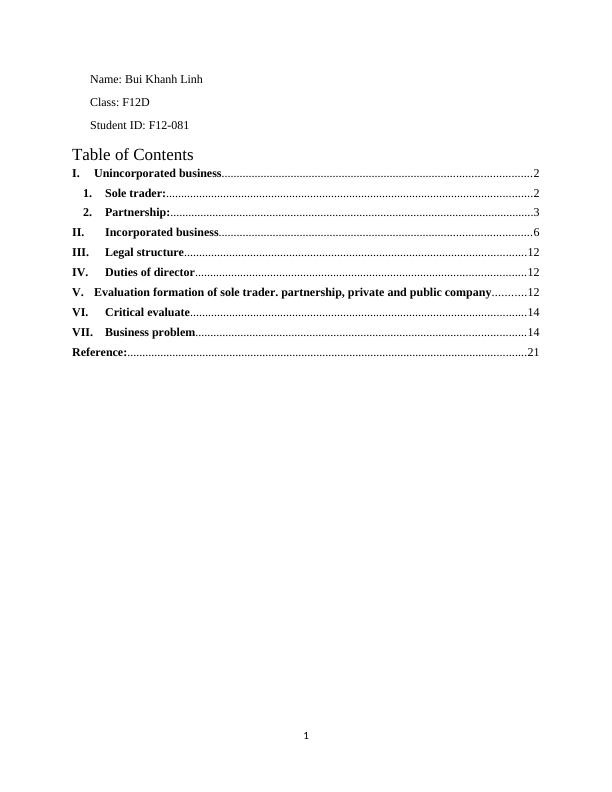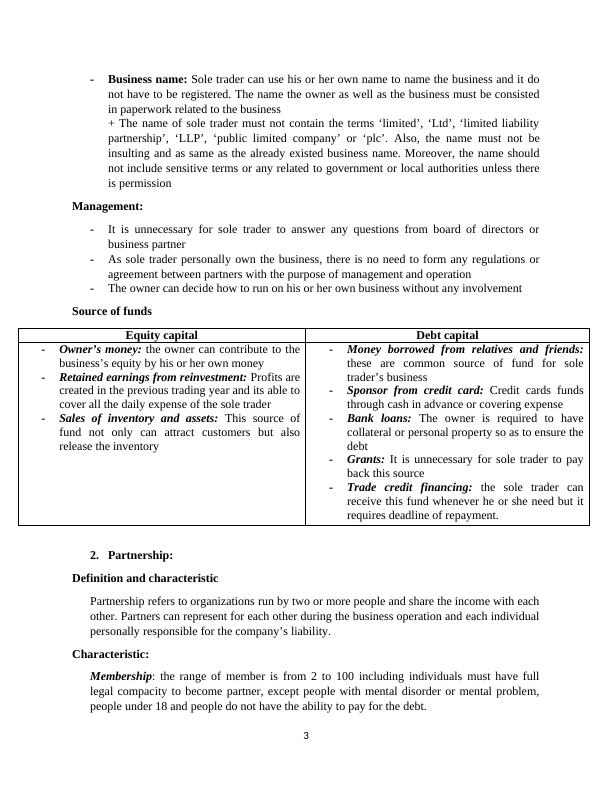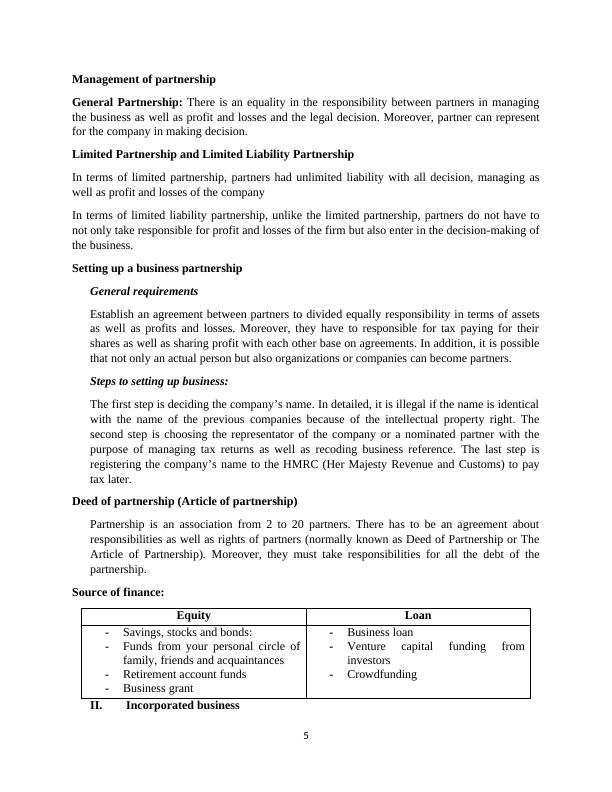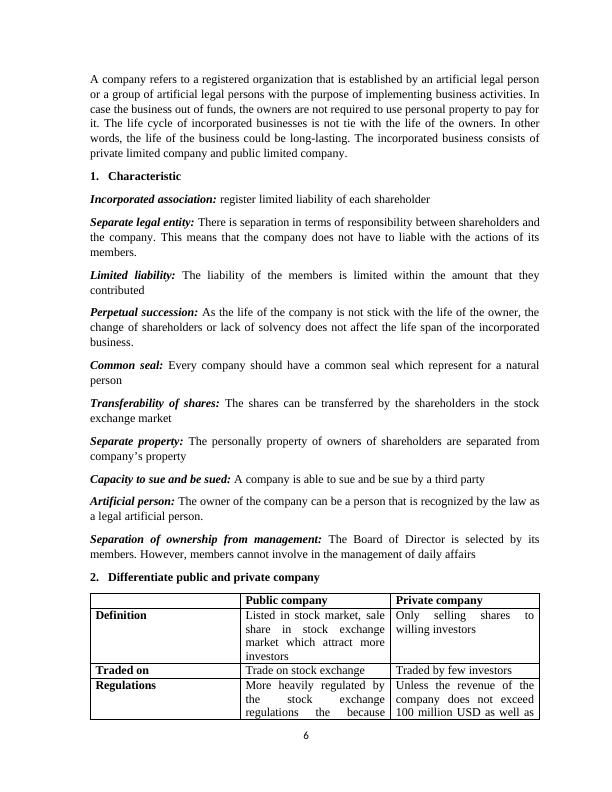Types of Businesses and Business Activities
Added on 2021-04-14
21 Pages7917 Words110 Views
Name: Bui Khanh LinhClass: F12DStudent ID: F12-081Table of ContentsI.Unincorporated business.......................................................................................................21.Sole trader:..........................................................................................................................22.Partnership:.........................................................................................................................3II.Incorporated business........................................................................................................6III.Legal structure..................................................................................................................12IV.Duties of director..............................................................................................................12V.Evaluation formation of sole trader. partnership, private and public company...........12VI.Critical evaluate................................................................................................................14VII.Business problem..............................................................................................................14Reference:.....................................................................................................................................211

I.Unincorporated business Unincorporated business related to organizations that not separate of legal identity from theowners. The owners are bear all of the liability of the business. There are two types ofunincorporated business which are sole trader (sole proprietorship) and partnership (AustralianGovernment, 2010). The owner of unincorporated busines is personally liable with the liabilitiesof the business. As long as the owner live, the unincorporated business still exist. 1.Sole trader:Definition: Sole trader is a type business that is own and manage by an individual. The owner ofsole trader responsible for all the profit and loss of his or her own business.Characteristic:-Single ownership: the business is owned by one person. He or she personally contributea whole capital for his or her own business-Personally control: The owner wholly control of the business. He or she may asksomeone for advice but the decision-making right belongs to the owner.-No legal entity: There is no separation between the legal entity and the owner of thebusiness. In case the owner is passed away or incapable of insolvency, the business isconsidered to be dissolved. -Unlimited liability: The owner must responsible for all the debt incurred during businessoperation. If the asset is not enough to pay for the debt, the owner has to use personalproperty to pay for it.-Personally own profit and losses: The sole trader personally bear all the profit as wellas losses of the business -Small scope: As the sole trader has limited source of fund then the operational scope islimited-Legal formation is unnecessary: Legal formalities in terms of establishing, managementand dissolve is not require Formation-General requirement: It is required to inform the HMRC in order to pay tax throughself-assessment. Therefore, sole trader have to filling the tax return annually. -Responsibility: 'Sole trader have to register for the National Insurance number if thebusiness is operated in the UK+ Sole trader must keep all the business records in terms of sales and expenditure+ Filling the tax return through Self-assessment yearly+ Paying the personal income tax based on the profit as well as national insurance interms of class 2 and 4+ It is required that in case the revenue of sole trader exceed £85,000. Sole trader can alsoregister for VAT voluntarily if it is appropriate with his or her business+ In case the business related to construction industry, sole trader have to register withthe HMRC for CIS (Construction Industry Scheme)2

-Business name: Sole trader can use his or her own name to name the business and it donot have to be registered. The name the owner as well as the business must be consistedin paperwork related to the business+ The name of sole trader must not contain the terms ‘limited’, ‘Ltd’, ‘limited liabilitypartnership’, ‘LLP’, ‘public limited company’ or ‘plc’. Also, the name must not beinsulting and as same as the already existed business name. Moreover, the name shouldnot include sensitive terms or any related to government or local authorities unless thereis permissionManagement:-It is unnecessary for sole trader to answer any questions from board of directors orbusiness partner-As sole trader personally own the business, there is no need to form any regulations oragreement between partners with the purpose of management and operation-The owner can decide how to run on his or her own business without any involvementSource of fundsEquity capitalDebt capital-Owner’s money: the owner can contribute to thebusiness’s equity by his or her own money-Retained earnings from reinvestment: Profits arecreated in the previous trading year and its able tocover all the daily expense of the sole trader-Sales of inventory and assets: This source offund not only can attract customers but alsorelease the inventory-Money borrowed from relatives and friends:these are common source of fund for soletrader’s business -Sponsor from credit card: Credit cards fundsthrough cash in advance or covering expense-Bank loans: The owner is required to havecollateral or personal property so as to ensure thedebt-Grants: It is unnecessary for sole trader to payback this source-Trade credit financing: the sole trader canreceive this fund whenever he or she need but itrequires deadline of repayment.2.Partnership:Definition and characteristicPartnership refers to organizations run by two or more people and share the income with eachother. Partners can represent for each other during the business operation and each individualpersonally responsible for the company’s liability. Characteristic:Membership: the range of member is from 2 to 100 including individuals must have fulllegal compacity to become partner, except people with mental disorder or mental problem,people under 18 and people do not have the ability to pay for the debt. 3

Unlimited liability: All the members are collectively and individually for all the debts of thebusiness. They have to use their personal property and asset to pay for the liability in case theasset of the company is not enough to pay for the debt. Sharing of profit and loss Profits and losses are divided proportionally based on agreementbetween members. In case any terms in the contract is broken, the profit as well as losses isdivided equallyMutual agency All the partners are represent for the company. Each of their action is bindingthe company as well as each other. Voluntary registration The registration to become a member of the partnership is notmandatory but is recommended. One of the benefits is that it is possible to sue to the court incase there is a dispute incur internal or external of the companyContinually Partnerships may dissolve upon partners death, bankruptcy or retirement. Orelse, the remain partners could continue the operations by making new agreement.Contractual relationship It is possible to establish and maintain the relationship betweenmembers by contract Trader of interest Partners must be given unanimous is there is any transfer of interestbetween each other.Types of partnershipPartnerships can be divided into 2 types which are general partnership and limitedpartnership which are general partnership and limited partnership. On the one hand,general partnership means that all the members are partners, equally unlimitedresponsible obligated to the company, and equally sharing profits as well as losses. Onthe other hand, limited partnership composes of not only one general partner responsiblefor running business operations but also one or more members who do not participate inbusiness activities and do not have any legal binding.4PartnershipGeneral partnershipLimited partnershipLimited partnershipLimited liability partnership

Management of partnershipGeneral Partnership: There is an equality in the responsibility between partners in managingthe business as well as profit and losses and the legal decision. Moreover, partner can representfor the company in making decision. Limited Partnership and Limited Liability PartnershipIn terms of limited partnership, partners had unlimited liability with all decision, managing aswell as profit and losses of the companyIn terms of limited liability partnership, unlike the limited partnership, partners do not have tonot only take responsible for profit and losses of the firm but also enter in the decision-making ofthe business.Setting up a business partnershipGeneral requirementsEstablish an agreement between partners to divided equally responsibility in terms of assetsas well as profits and losses. Moreover, they have to responsible for tax paying for theirshares as well as sharing profit with each other base on agreements. In addition, it is possiblethat not only an actual person but also organizations or companies can become partners. Steps to setting up business:The first step is deciding the company’s name. In detailed, it is illegal if the name is identicalwith the name of the previous companies because of the intellectual property right. Thesecond step is choosing the representator of the company or a nominated partner with thepurpose of managing tax returns as well as recoding business reference. The last step isregistering the company’s name to the HMRC (Her Majesty Revenue and Customs) to paytax later. Deed of partnership (Article of partnership)Partnership is an association from 2 to 20 partners. There has to be an agreement aboutresponsibilities as well as rights of partners (normally known as Deed of Partnership or TheArticle of Partnership). Moreover, they must take responsibilities for all the debt of thepartnership.Source of finance:EquityLoan-Savings, stocks and bonds: -Funds from your personal circle offamily, friends and acquaintances-Retirement account funds-Business grant-Business loan-Venture capital funding frominvestors-Crowdfunding II.Incorporated business5

A company refers to a registered organization that is established by an artificial legal personor a group of artificial legal persons with the purpose of implementing business activities. Incase the business out of funds, the owners are not required to use personal property to pay forit. The life cycle of incorporated businesses is not tie with the life of the owners. In otherwords, the life of the business could be long-lasting. The incorporated business consists ofprivate limited company and public limited company.1.CharacteristicIncorporated association: register limited liability of each shareholderSeparate legal entity: There isseparation in terms of responsibility between shareholders andthe company. This means that the company does not have to liable with the actions of itsmembers.Limited liability: The liability of the members is limited within the amount that theycontributedPerpetual succession: As the life of the company is not stick with the life of the owner, thechange of shareholders or lack of solvency does not affect the life span of the incorporatedbusiness.Common seal: Every company should have a common seal which represent for a naturalpersonTransferability of shares: The shares can be transferred by the shareholders in the stockexchange marketSeparate property: The personally property of owners of shareholders are separated fromcompany’s propertyCapacity to sue and be sued: A company is able to sue and be sue by a third partyArtificial person: The owner of the company can be a person that is recognized by the law asa legal artificial person.Separation of ownership from management: The Board of Director is selected by itsmembers. However, members cannot involve in the management of daily affairs 2.Differentiate public and private companyPublic companyPrivate companyDefinitionListed in stock market, saleshare in stock exchangemarket which attract moreinvestorsOnly selling shares towilling investorsTraded onTrade on stock exchangeTraded by few investorsRegulationsMore heavily regulated bythestockexchangeregulations the becauseUnless the revenue of thecompany does not exceed100 million USD as well as6

End of preview
Want to access all the pages? Upload your documents or become a member.
Related Documents
(docs) Business Law Assignment Samplelg...
|19
|5229
|25
Online Library for Study Material with Solved Assignments - Deskliblg...
|12
|2383
|286
Nature Formation and Management of Business Organizationslg...
|10
|2643
|451
Business Law and the Legal System - Case Studieslg...
|27
|2844
|29
Options for Reorganising IOM Solutions: A Case Studylg...
|9
|2609
|91
Legal Issues in Business Organizations, Tourism and Events Organizationslg...
|8
|2283
|118
